
Many will say that the invention of the wheel is the pivotal point in man’s history – others will claim that it is the invention of hand tools and portable weapons. Whichever argument you might tend to believe, one fact cannot be disputed – it wasn’t until those tools, weapons, and wheels were made of steel that mankind had taken a permanent leap forward in his ability to better adapt to his environment – and make that environment adapt to him.
Steel makes those wheels strong enough to manage harsh terrain or achieve high speeds. Steel makes the weapons that turn a trained soldier into a deadly combatant. And steel allowed buildings to rise higher, the power of steam to be harnessed, and the industrial revolution to circle the globe on shiny rails. And so, while it is always a joy to celebrate the new technologies that allow our firearms to be lighter and faster, there is something about the feel of steel in the hand that gives one a sense that it is indestructible.
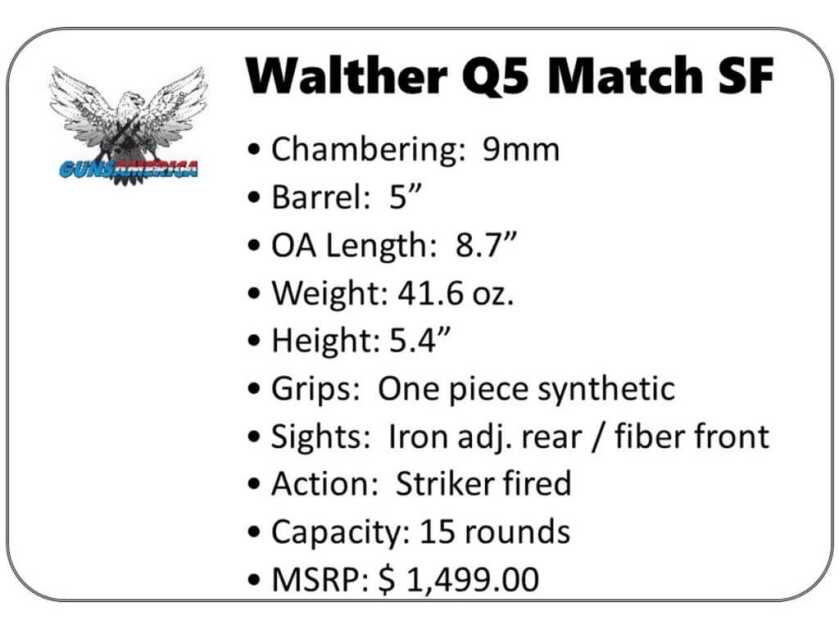
Such is the case with the Walther Q5 Match SF (steel frame) handgun. It is not much different from its sibling the polymer-framed Q5 Match, except that it is heavy – and solid – and stiff. The feel of steel in the hand is much different from polymer, and today’s competitive handgun shooters have been rediscovering that the extra weight while tiring to tote around on the hip is usually an advantage when shooting. A heavier stiffer steel-framed gun tends to stay put. There is less muzzle rise with each shot, which means the sights are back on target much faster. Checkering cut into a steel frame provides a bond to the shooter’s hand that is hard for a molded texture to match. Some could also argue that the stiffness of the steel frame improves accuracy versus the flexing of the polymer in that last tiny fraction of a second that counts the most. And of course, higher pressure loads can be regularly fired from all-steel guns than can be from polymer frames.

Does this mean that steel beats polymer every time? Of course not – there are endless variables and scenarios in which either would be the better tool for the job that day. What is worth celebrating is that Walther is giving us the choice. Those who prefer the polymer-framed Q5 Match and the PPQ will be pleased to know that they are not going away. The new steel frame (SF) is an addition that Walther thinks the market needs. Which brings us to…
WHO IS IT FOR?
As I mentioned, the allure of the steel frame tends to be among the high-speed pistol competition shooters. IPSC, IDPA, USPSA, etc. The ‘controllability’ and steadiness of a heavier gun allow more shots to be fired on target in a given time. Consider that most of the shooting sports have a weight limit, not a minimum weight, and you begin to understand that more weight = more advantage. I think this pistol is for the relatively accomplished competitor who is ready to move to the next level of hardware. Most especially, those who have been shooting a Walther PPQ 5” or a Q5 Match polymer-framed gun. The transition to the SF is seamless. All controls are identical and the trigger… oh, the trigger… is the same “best in class” bang switch that you can get in a mass production handgun. This one measures 4 lbs. 9 oz. at the break. This doesn’t mean that new shooters would not benefit from the SF, but it does cost substantially more than the two poly-framed Walthers I just mentioned. Most new match shooters start out with a quality, well-recommended gun that leaves money for all the other gear they need. But we’ve all seen the guy that shows up with the $4k custom 1911 for his first match, too. Every bell curve has to have those two ends. Bottom line, if you are looking for the flagship competition handgun, or you have made up your mind to ‘go heavy or go home’, then I think you’re in the target market.

HOW IS IT DIFFERENT?
Besides, you know – being made of steel… the Q5 Match SF is mostly identical to the Q5 Match polymer-framed handgun, which was in turn mostly identical to the PPQ 5” pistol. Setting aside weight for a moment, and not reading off the spec sheet – here are the things I notice the most about the SF versus the polymer-framed Q5: 1. First and foremost – MUCH better grip surface. I love the design of the paisley stippling on the Walther polymer frames, but they don’t offer much in the way of friction. At this writing, I am unable to determine for certain if the material is G10, but it seems to be. The grip is a one-piece design that covers the handle like a clamshell. It has the same ‘multiple palm swell’ topology as the molded polymer frames, but its surface is cut into a very effective and interesting pattern. I will describe it as a continuous series of 3-dimensional cubes.

It is very superior in its grip friction and quite fascinating to look at. Continuing that practical need for a bond with the shooter’s hand, the front strap is wonderfully checkered. The vertical cuts of the checkering extend upward well into the nicely undercut trigger guard, and downward to the very toe of the magazine well. Walther has kept the same ergonomic shape and feel from the PPQ family. There is also some nice checkering on the front face of the trigger guard, for people who learned to shoot from watching ‘80s television. 2. Wicked awesome beavertail. I don’t know that it makes much practical difference, but it looks way cooler than the polymer version. 3. Full-length dust cover. This means three things – more weight out front for balance and resistance to muzzle lift; a bit more Picatinny rail for those lights; it may not fit your existing holster.

That last one is one to take note of if you think you can drop this gun into your favorite PPQ or Q5 holster. I have one that I can use, and one that I can’t. Needless to say, my favorite newest one is the one I can’t. That’s it. I know there are a few more subtle differences, but those are the ones that will make a difference. Oh, and one last point – in anticipation of many questions: No, you cannot swap the slides/frames between the polymer Q5 and this SF. They use a completely different slide locking design and are not compatible – even though they are identical in every other way.
SHOOTING THE Q5 MATCH SF
The day my FFL called to tell me the Q5 SF had arrived, I was making my final preparations as the local host of Massad Ayoob’s MAG-40 class, an annual class held at our range. However, as part of the class staff, it is customary to demonstrate the student’s final practical exam on the range – a qualification style course that is strictly timed. Mas suggested using the SF to shoot it, and I thought that was a brilliant idea. So, without so much as a single warm-up shot, the first 60 rounds I put through the new pistol took place with a full class of students watching, a famous YouTuber filming, and in competition against Massad Ayoob. Eh, no pressure!! You can see this is the companion video. How did I do? I shot a 299 of a possible 300… and I’ll take that. Mas – he shot a perfect 300, of course.

In between the more relaxed shooting and various testing of the gun, I was also able to shoot a steel challenge match – yet another practical test, and certainly the sort of use this gun is designed for. It was a flawless performance from the SF… even if I can’t claim the same for me. The sight picture was great, and the muzzle lift was nearly non-existent. I never adjusted the iron sights and they seemed to be ‘on’ even when I wasn’t.
To test the accuracy, I used several types of ammunition and did a couple of groups with the open iron sights and several with a Holosun HS507C installed. The tests ranged from 20 to 23 yards (the latter with the red dot) and results were good. An electronic optic with a good reticle, such as in the Holosun, is a great aid for shooting groups because of the ability to consistently hold on a finer point of aim than most open sights on handguns permit. But the standard sights on the Q5 SF come very close to that same level of precision. The front sight’s red light tube is very thin and makes a small and bright red dot for the shooter. With a mix of ball and hollow-point of various brands, groups averaged just over 2 ½” with the Holosun and under 2” with the open sights. The best 3-shot group of the tests was 0.573”, produced using SIG Sauer Elite Performance 124-grain V-Crown ammo, shooting from a CTK Precision rest.
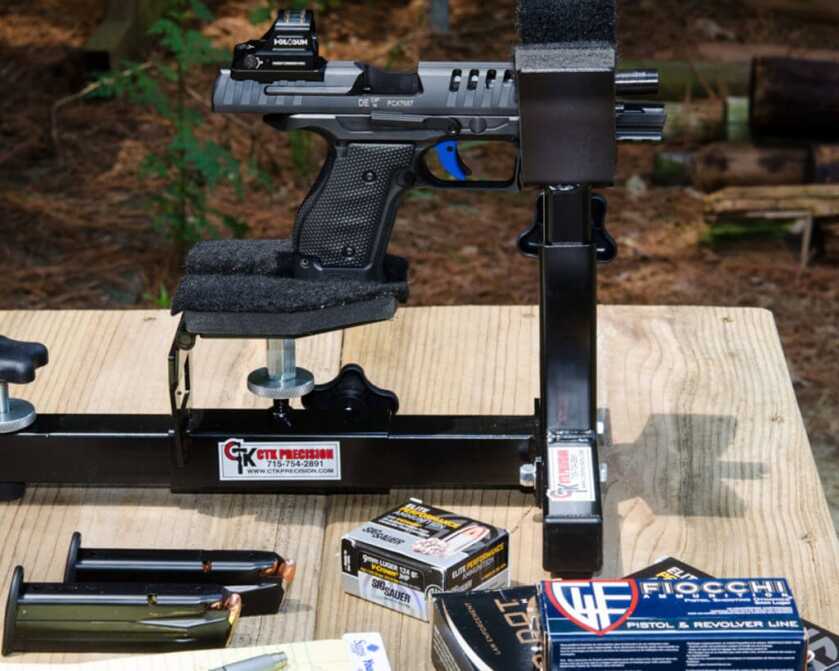
I’ve been seriously shooting a PPQ for years, and it was comforting that picking up the SF is like slipping your hand into an old glove. With one major exception – the grip texture. I’ve already commented about it, but I must say again that it is among the very best I’ve felt. One lost feature is the S-M-L backstraps that come with the polymer-framed PPQs. This gun fits my hand great, but if it didn’t, that size change is not available – at least not until other one-piece grip panels might be offered in the future. I could feel that the SF shot flatter than its lighter counterparts, and my forward thumb could feel the slight change of architecture to the forward upper frame, but aside from that, it is just a heavy PPQ.
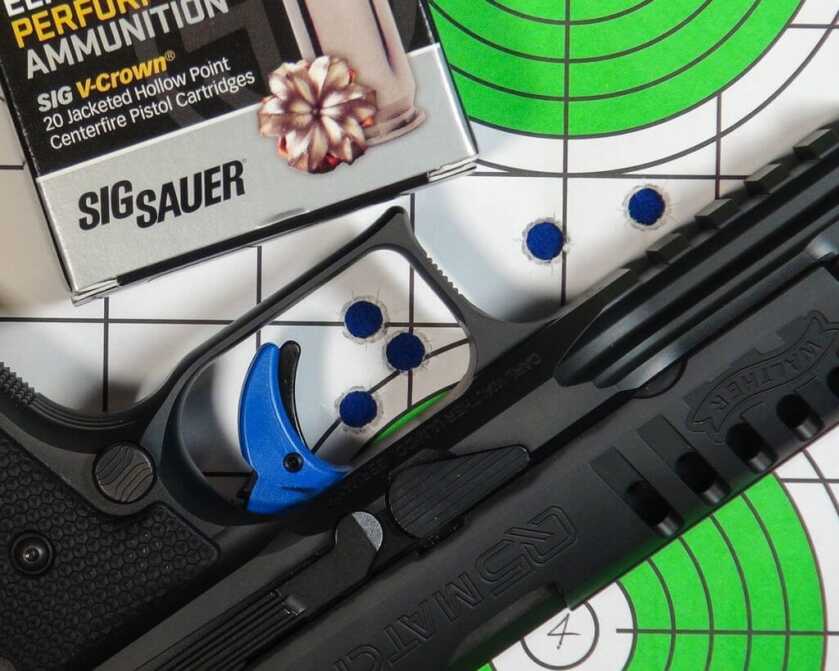

JUST MY OPINION
It’s a great time to be a firearms enthusiast. The marketplace has never before been so crowded with new and more innovative products, each manufacturer having to outdo themselves as well as their competition, year after year. For many, just trying to improve their design or give shooters that ‘better trigger’ or ‘more ergonomic pistol’ they are demanding is enough to keep the engineers pacing the floor at night. But if you are Walther Arms, one of the oldest and most respected gun makers, and you already have what most consider (this author among them) the best out-of-the-box striker-fired trigger in mass production, and ergonomics that have raised the industry bar – what do you do? You make a steel-framed gun that is exactly like the one everyone loves in polymer, that’s what. It’s a genius move, really. With more and more competitors making the switch to heavier pistols (which usually means a steel frame), Walther is staying in the conversation when it comes to match guns.

I don’t think the Q5 Match Steel Frame is for everyone, and I believe Walther understands and shares that view. It is the new flagship model for the serious competitor – the Walther you must have if you’re a Walther guy or gal. But based on materials and workmanship alone, the gun is understandably expensive for the more casual shooter who attends the match more as a social event than to bring home top honors. This Steel Frame model is the next step in the evolution of the modern Walther handgun, more specifically the PPQ family, and it’s a great step. This pistol is a demonstration of what can be achieved when customers are heard, envelopes are pushed, and ‘best in class’ status isn’t a laurel to rest on.



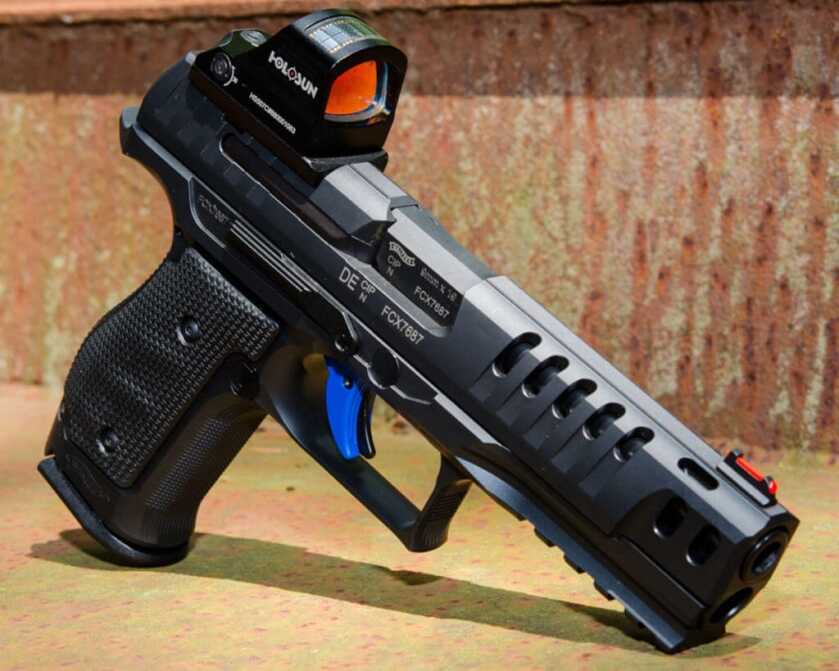
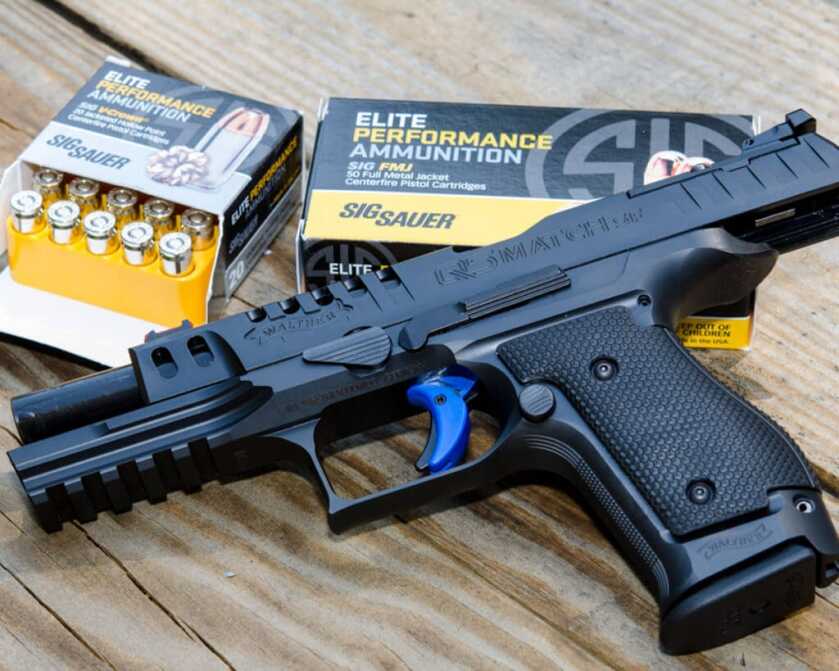

From iron sights to the red dot, yes the distance increased three yards, but to open up over 1.5″ from iron sights to the red dot? Doesn’t make sense to me.
I love it. But, Darn ! It’s a little to expensive the the average shooter.
But, I know that premium products don’t come cheap.
A Ford Focus is not the same as a Roles Royce
Thanks for a great post with lots of information
Rolls
looking for one HKP7M8; leather shoulder holster; clip pocket and 5 extra clips. Had all, sold all, sadly. Holster was made in Arizona.
Not knowing if you’ve fired one. How would you compare the trigger to the Canik Tp9 SFX?
Robert – I do own the TP9 SFX. The trigger is arguably lighter in the Canik, but it has that odd break point, rear of the 90-degree mark, that makes it feel odd. But, once you get used to it that issue goes away. The trigger on this Q5 Match SF, like all PPQ triggers, is very close to that in weight but also has a “solid” feel, if that makes sense. Both are very good – becomes a matter of personal preference.
Justin;
Have you tried the Canik 20 round mags in a Q5 yet? They work.
oh, looks good